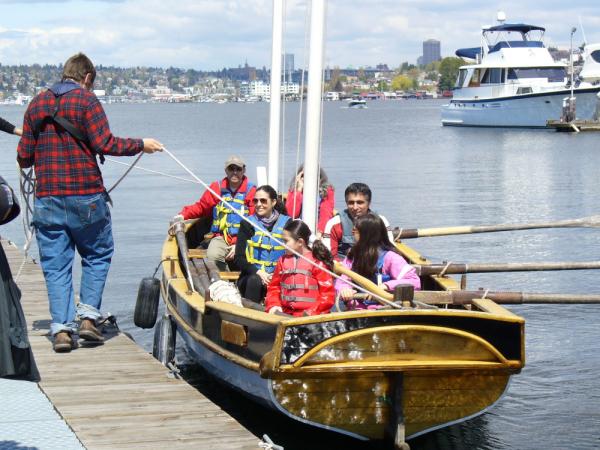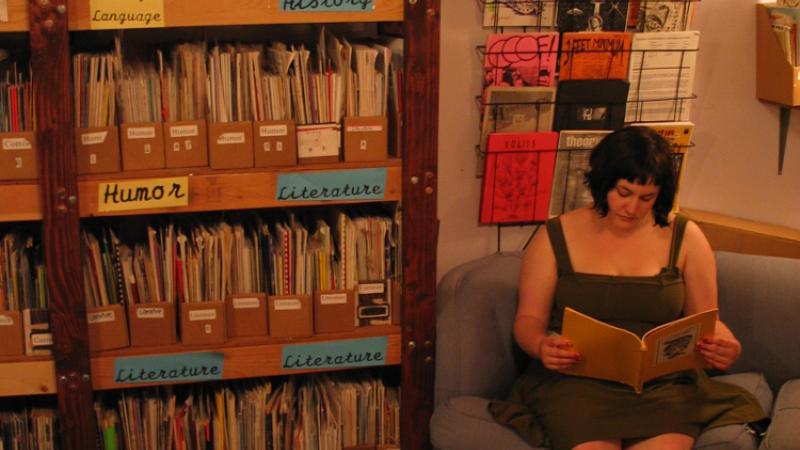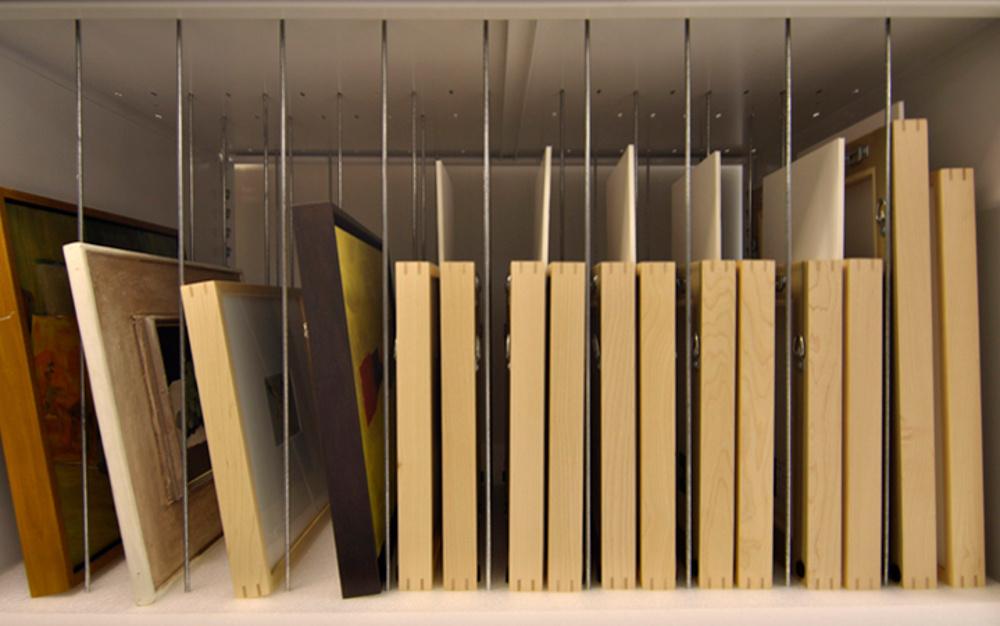Summer Road Trip! Next Stop: The Pacific Northwest

Take a boat ride on a historic boat with the Center for Wooden Boats. Free rides available every Sunday.
Courtesy of the Center for Wooden Boats

Take a boat ride on a historic boat with the Center for Wooden Boats. Free rides available every Sunday.
Courtesy of the Center for Wooden Boats
The relatively short distance between Seattle and Portland makes them favorite destinations for vacationers headed to the Pacific Northwest. The two cities are home to major cultural attractions such as the Space Needle, the Experience Music Project, Portland Museum of Art, and the Lan Su Chinese Garden. Both Seattle and Portland abound in cultural heritage organizations, big and small, that introduce the public to the rich and varied history and culture of the region. As you will see, NEH has assisted a number of these organizations in their efforts to preserve the cultural legacy of the region.
Seattle, Washington
Center for Wooden Boats
As a port city, maritime history is an important component of the history of Seattle and the surrounding area. The Center for Wooden Boats, located on the shore of Lake Union, explores the impact of the “small craft heritage” of the Pacific Northwest through exhibits, workshops, and on-the-water experiences. The center maintains an extensive collection of historic boats, boat plans, books and periodicals, photos, and archival materials related to the maritime history of the region. Visitors can see diagrams and models of wooden boats and learn about how they have been used in the past and how they are used today. They can even sail on a boat from the collection, either through a rental or during the center’s free public sail held every Sunday of the year. In 2008, the Center for Wooden Boats received a Preservation Assistance Grant from NEH to carry out a conservation assessment of its collections. This effort helped lay the groundwork for a long-term conservation plan for the museum. The boathouse and museum of the Center for Wooden Boats are open Tuesday through Sunday from 10 a.m. to 8 p.m. http://cwb.org/
Burke Museum of Natural History and Culture
Outside the city center, on the Seattle campus of the University of Washington, you can find the Burke Museum of Natural History and Culture, one of the preeminent natural history museums in the region. Founded in 1885 by a group of teenagers in the Young Naturalists Society, the Burke was originally designated the Washington State Museum in 1899. Along with changing special exhibits, the museum offers visitors the geological, natural, and cultural history of the Northwest through permanent exhibits, such as The Life and Times of Washington State and Pacific Voices. One of the treasures of the Burke is its collection of more than 40,000 ethnographic objects, with special emphasis on materials from North and South America, Southeast and East Asia, and the Pacific. To help ensure the long-term preservation of this collection, the museum was awarded a Preservation Assistance Grant in 2010 to purchase equipment to monitor the temperature and humidity levels in storage areas and galleries. The Burke Museum is open most days of the year from 10 a.m. to 5 p.m., with free admission on the first Thursday of each month. http://www.burkemuseum.org/
Nordic Heritage Museum
Get a more in-depth look at some of the Northwest’s major immigrant groups at Seattle’s Nordic Heritage Museum. There you will find permanent exhibits describing the history of migration from Scandinavia to the United States, and in particular, to the Pacific Northwest, where many immigrants adapted their traditions of fishing and operating lodging houses. Temporary exhibits at the Nordic Heritage Museum range from the history of immigration to contemporary artworks and the influence of Scandinavian culture in the United States. In 2010, the museum was awarded a Preservation Assistance Grant to purchase preservation supplies to rehouse its collection of historic textiles, many pieces of which were brought to the United States from Scandinavia. The museum also acquired monitoring equipment to help ensure that these materials would be maintained under appropriate environmental conditions. The Nordic Heritage Museum is open Tuesday through Sunday, with free admission on the first Thursday of each month. http://www.nordicmuseum.org/
Richard Hugo House
Seattle is known as the birthplace of “grunge” and is home to a thriving counterculture. So it should come as no surprise that one of the world’s largest collections of zines—defined as “self-published, small circulation, noncommercial booklet or magazine, usually produced by one person or a few individuals”—is located in the Emerald City. Seattle’s Richard Hugo House oversees the Zine Archive and Publishing Project (ZAPP), containing a collection of more than 20,000 zines from around the world. In addition, the Hugo House serves as a writer’s retreat, offering classes, lectures, and rotating exhibits of zines in the archive’s gallery. To improve the storage of these materials, the Richard Hugo House won a Preservation Assistance Grant in 2010 and was able to place its holdings in archival-quality boxes and cabinets. ZAPP is open to researchers and the public on Wednesday from 4 p.m. to 8 p.m., Thursday from 1 p.m. to 5 p.m., and Saturday from 1 p.m. to 5 p.m. http://hugohouse.org/content/zapp
Portland, Oregon
Oregon Historical Society
Three hours to the south by car is Portland, Oregon, commonly known as the “City of Roses." The source of this moniker is most likely the city’s annual flower festival first launched in the 1880s. Although only incorporated in 1851, Portland has an interesting history and serves as the endpoint for the famous Oregon Trail. To learn more about the history of the city and state, one of your first stops should be the Davies Family Research Library at the Oregon Historical Society. There visitors can explore a vast collection of books, maps, manuscripts, serials, and oral histories, as well as more than two million photographs and nearly nine million feet of film and videotape. These collections cover a myriad of topics including Native American cultures, European settlement, maritime history, and genealogy. In 2008, the Oregon Historical Society was awarded a Preservation Assistance Grant to rehouse a portion of its collection, including business records, military records, ethnographic materials, correspondence, diaries, scrapbooks, playbills, posters, and advertising materials dating from the 1800s to the present, all reflecting the history and culture of Oregon and the greater Pacific Northwest. The library is open 1 p.m. to 5 p.m. on Tuesday and from 10 a.m. to 5 p.m. on Wednesday through Saturday. http://www.ohs.org/
Architectural Heritage Center of the Bosco-Milligan Foundation
Portland is known for its focus on urban planning and a commitment to sustainable or “green” architecture. The Bosco-Milligan Foundation’s collection documenting Portland’s architecture is located at the Architectural Heritage Center, one of the largest of its kind in the western United States. Holdings include representations of the various architectural methods and styles that dominated the 19th and 20th centuries, including Ironwork, Stonework, Arts & Crafts, and Victorian building styles. A particularly valuable—and vulnerable—part of its collection is 236 stained glass windows, salvaged from 19th-century Portland-area buildings that were demolished. The windows are presently used in the center’s educational and public programming on traditional building crafts, the art of local practitioners, and the architectural styles in Portland. In 2010, the Bosco-Milligan Foundation was awarded a Preservation Assistance Grant to purchase shelving to ensure the safe storage of these fragile items. The foundation displays its holdings on a rotating basis, and the collection can be viewed Wednesday through Saturday from 10 a.m. to 5:00 p.m. http://www.visitahc.org/
Douglas F. Cooley Memorial Art Gallery at Reed College
A short distance from downtown Portland is the Library of Reed College where visitors may visit the Cooley Art Gallery, which houses exemplary works of art from Europe and North America. Among its gems are works on paper by masters such as Rembrandt, Daumier, Manet, and Rothko. The gallery also hosts special exhibits by contemporary artists. In 2011, Reed College used a Preservation Assistance Grant to carry out an assessment of its prints and drawings, many of which had been stored in unprotected wooden cabinets. The grant made it possible to place 500 of these works of art on metal shelving and in acid-free archival boxes. The Douglas F. Cooley Memorial Art Gallery is open from 12 p.m. to 5 p.m., Tuesday through Sunday. http://www.reed.edu/gallery/
Washington County Museum
And finally, just outside Portland, is the suburb of Hillsboro, home to the Washington County Museum. There visitors can explore the history, culture, art, and science of this region, known for its rich farmland, as well as its high-tech industry. The Washington County Museum houses a collection of more than 40,000 objects that include Native American artifacts, agricultural implements, furniture, logging tools, and textiles, as well as prints, paintings, and library and archival materials. Current exhibits include Americans All: The Bracero Program in Washington County, which focuses on the history of the Latino community, the largest on the West Coast north of Sacramento and Put a Bird on It: Nature Photography of William L. Finley, which presents forty black-and-white bird photographs from naturalist and wildlife conservationist William Finley. In 2008, the Washington County Historical Society and Museum received a Preservation Assistance Grant to transfer its collection of objects from a cramped storage space to preservation-quality metal shelving. The museum is open Wednesday through Saturday, 10 a.m. to 5 p.m., and Sunday, 12 p.m. to 5 p.m. http://www.washingtoncountymuseum.org/



